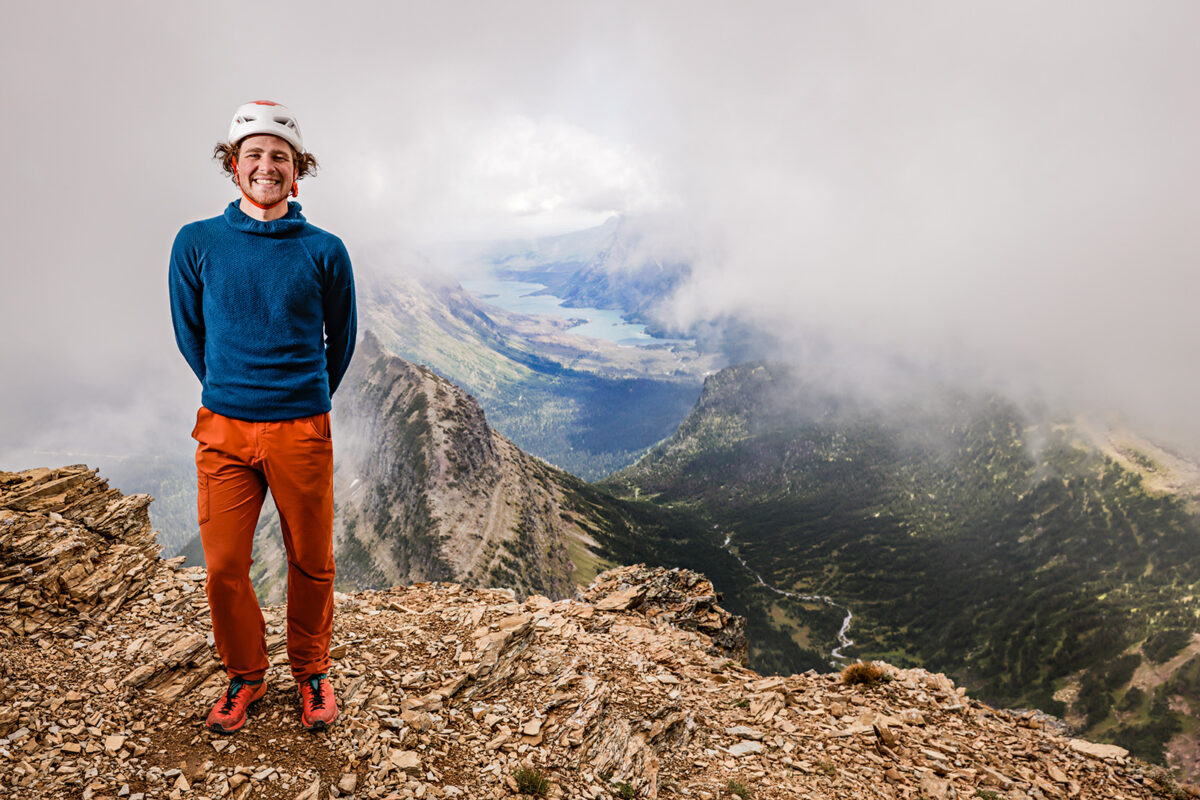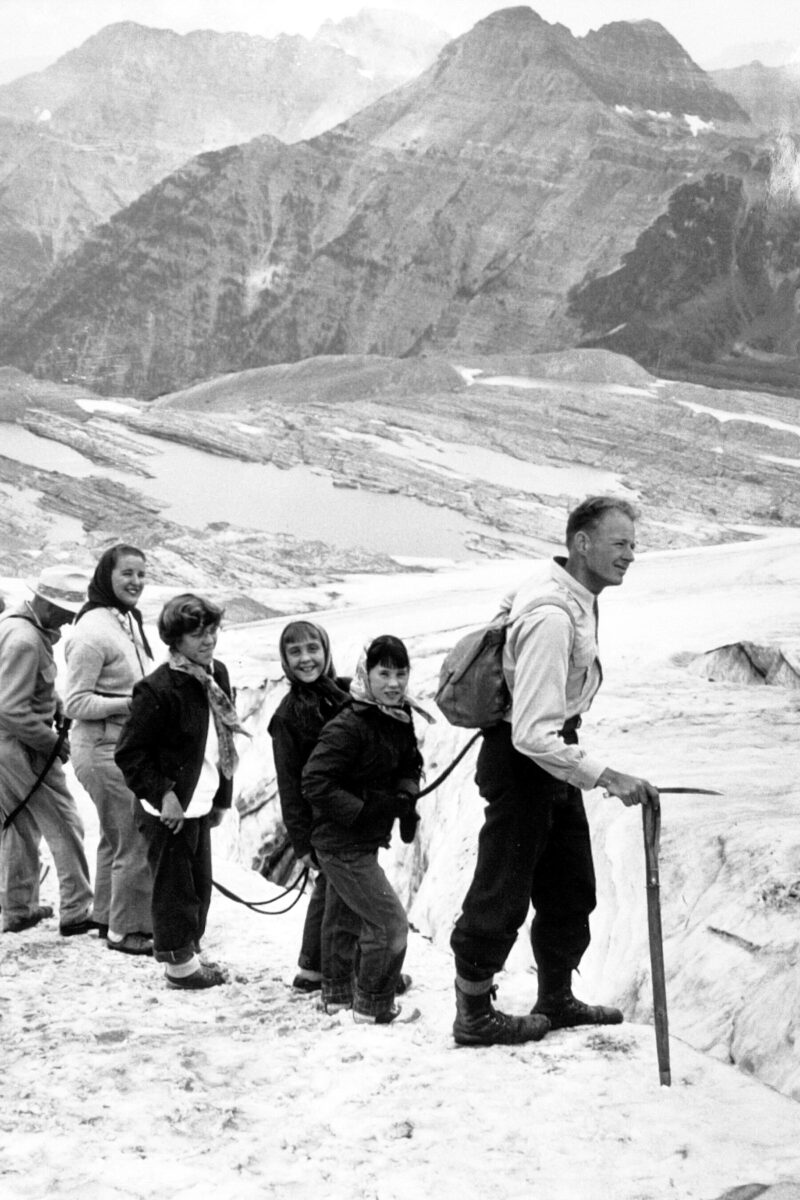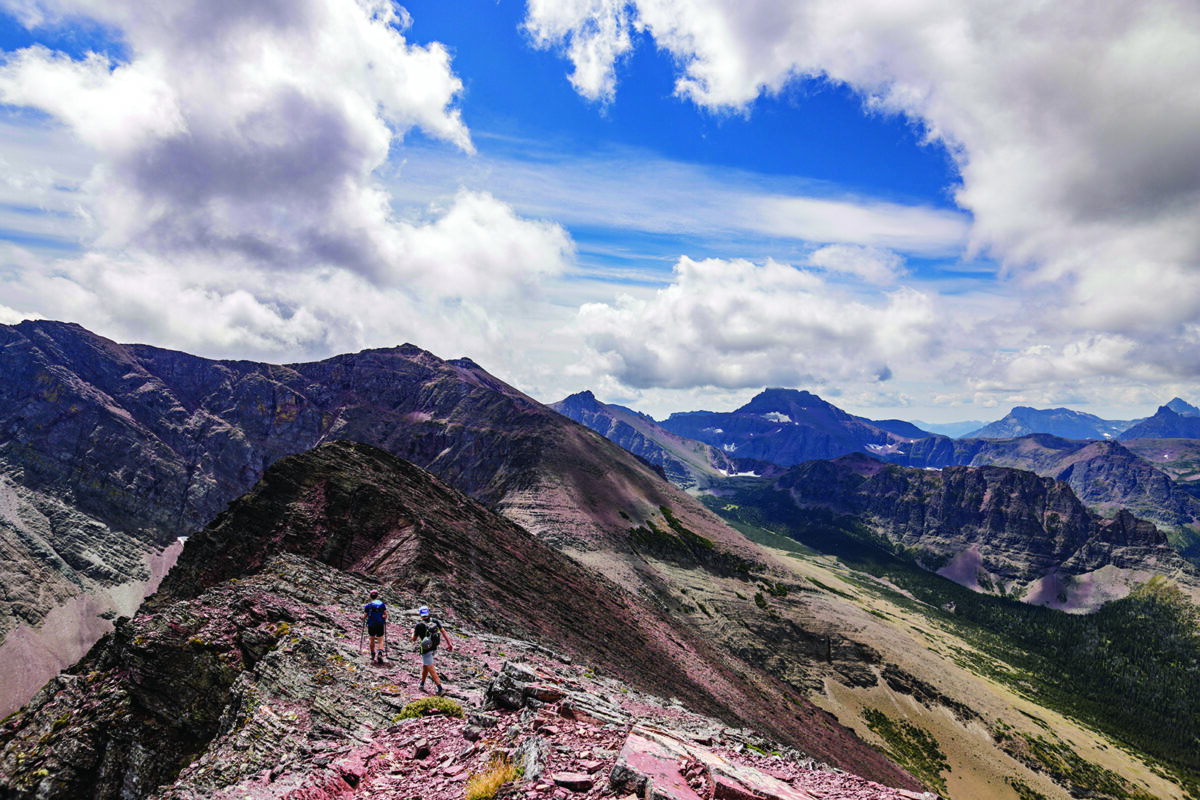The New Guard of Glacier Mountaineering
For more than 40 years, the Glacier Mountaineering Society has helped its members explore the farthest reaches of Glacier National Park while promoting an ethic of stewardship and safety. Now, following the recent deaths of some of its most dedicated members, the next generation of climbers is taking up the mantle.
By Tristan Scott
Piloting his car up the Going-to-the-Sun Road in Glacier National Park, Keegan Siebenaler, 23, riffs on housing policy initiatives, clean energy and politics with the same rhythmic fluidity that he employs while rapping along with the Kendrick Lamar track bumping through his Bluetooth, but he quiets as the summit pinnacle of Mount Reynolds swings into view.
Born and raised in Kalispell, Siebenaler returned home to the Flathead Valley last year after earning an environmental engineering degree at the University of Notre Dame. Having closed out the summer by fulfilling a year-long commitment as an AmeriCorps volunteer, he’s laying plans for his future by applying for remote policy jobs in the clean energy space.
As the expansive view of Reynolds dominates the windshield of his mom’s station wagon, however, Siebenaler’s silence speaks volumes about his deeper ambitions.
“In the past year in particular, I keep thinking of that list of 234 named peaks in Glacier and what it means,” Siebenaler says, referring to an official catalog of the park’s prominences established in 2003 by the Glacier Mountaineering Society. “I’m not even close to halfway there. Even if you climb 200 of those mountains you’re really only halfway there. But I think that’s why that list feels so significant — it doesn’t just indicate that you’ve climbed 234 peaks, it means that you have chosen a lifestyle that allows you to spend all your time in Glacier National Park. And that means something to me.”
During his tenure as a university student in Indiana, Siebenaler found himself yearning to be nearer to the ragged expanses of peaks that punctuate Glacier’s skyline, and spent much of his free time watching climbing movies or swiping through iPhone photos of the mountains he’d summited. “I remember thinking, ‘Keegan, if you make it back to Montana you need to have the same ambition every day that you do when you fly back for summer break. You need to seize the opportunity to climb and not just sit on the couch.”
“I definitely hold that in my mind today,” he adds, “and that yearning has driven me in the past year. You make tradeoffs in your life, but for me it’s important to be around these mountains and this community and to embrace it right now, because you don’t know how long you have and you don’t know how fit you’re going to be when you are 70.”

While the allure of the unknown has fed the compulsions of mountaineers for centuries, it has tightened its grip on the rarefied climbing community around Glacier National Park with the loss of some of its most committed and knowledgeable members. Among the ranks of local mountaineers whose statures betray a lifelong dedication to exploring the intricate contours of Glacier National Park’s peaks and ridges, few were more familiar or more accomplished than Brian Kennedy and Jack Beard, who both died in July 2022 while descending from a forbidding crag called Dusty Star. Less than six months later, Denis Twohig, another pioneer in Glacier’s climbing community and the founding father of the Glacier Mountaineering Society (GMS), died from complications from lung cancer.
In addition to their vast contributions toward canonizing the classic ascents in Glacier, the three men inspired countless young climbers to ply its mountains and share the joy of their experiences with less-accomplished climbers, thereby continuing a generational exchange that is the lifeblood of climbing in the park.
In the vast mountaineering universe, Glacier National Park inhabits its own galaxy, and for many years the man at the center of all that swirling geologic matter and explorative energy was J. Gordon Edwards, the architect of climbing in the park and an affable conquistador, laying siege to its many peaks while inspiring scores of other climbers to scramble in his footsteps.
Edwards literally wrote the book on climbing in the park, and 55 years after publishing his timeless peak-bagging manual, “A Climber’s Guide to Glacier National Park,” his influence continues to flourish on mountaineers new and old; some of them met Edwards through the Glacier Mountaineering Society, while others heard tales of his daring routes or read his meticulously scripted beta on the mimeographed sheets that would eventually become the bible for Glacier’s rock enthusiasts.
Today, 42 years after the club’s formation and nearly 80 years after the late Edwards first arrived in Glacier as a research entomologist, scores of climbers attribute their passion for and knowledge of the park’s secrets to the GMS, and to Edwards’ involvement in the club, including some of the most prolific and accomplished mountaineers in the region.
“I wanted to learn the routes to the summits of the peaks in Glacier Park, and who better to follow than Gordon Edwards, who wrote the book about climbing in the park?” according to Kennedy, the late GMS member and former editor, publisher and owner of the Hungry Horse News, who died following last year’s first ascent of Dusty Star Mountain’s true summit.

The concept for GMS emerged in the late 1970s, when a cadre of dedicated mountaineers known as the “Swiftcurrent Regulars” convened each summer in the Many Glacier and Swiftcurrent region, swapping route descriptions, dreaming up big traverses and embarking on ambitious explorations of the ridges and peaks radiating out of the valleys.
The idea was simple — Glacier’s high-alpine country was a puzzle box waiting to be unlocked, and sharing that challenge with others while recording the annals of mountain exploration was a noble obligation.
One Glacier devotee who adopted that philosophy was Denis Twohig, a passionate climber who began publishing Going-to-the-Sun Magazine, featuring colorful spreads of the off-trail adventures that a clutch of mountaineers was dispatching with regularity.
“During that period of time I got to know a lot of the regular scramblers and climbers in Glacier National Park, including the pied piper of Glacier’s climbers, J. Gordon Edwards,” Twohig, who died in January 2023, told the Flathead Beacon in 2016. “And it was through this association that I got the idea to start a club.”
Twohig was already publishing a handbook to Glacier for motorists and hikers, and in 1980 he used the handbook to place a subscription application for the new magazine, describing it on the order form as “your introduction to the majesty and splendor of Glacier National Park.”
That same year, Twohig debuted Going-to-the-Sun Magazine, which would become the official journal of the Glacier Mountaineering Society and is still published today. In the following edition, he announced the formation of the club, describing it as “a society of backpacking and climbing enthusiasts sharing a common link with the mountain wilderness experience.”
The Glacier Mountaineering Society was still in its “embryonic stages,” Twohig said, when he used Going-to-the-Sun Magazine to publish the account of an historic first ascent by two of the club’s original charter members, legends Terry Kennedy (no relation to Brian) and his partner Jim Kanzler.
Over the course of three days in September 1979, the 25-year-old Kennedy and 31-year-old Kanzler inched their way up the sheer north face of Mount Siyeh, a menacing, monolithic tower of limestone that is widely considered the most difficult climb in the park. The duo had attempted the route three times prior, succeeding on their fourth attempt after spending two cold nights suspended from the massive wall.
Depending on how you measure it, the north face of Siyeh is either the first or second tallest technical rock face in Glacier National Park, making it the first or second tallest in the Lower 48 — the other tallest rock face, the north face of Mount Cleveland, was climbed for the first time in 1976, also by Terry Kennedy and Kanzler, as well as Steve Jackson.
Even while a handful of Glacier Mountaineering Society members were making history in the park, the spirit of the club was one of inclusion, not elitism, and its members exuded a warmth and affection for the art of climbing that Edwards helped foster.

“I first came across Glacier Mountaineering Society in 1991 when I was working as a waiter at Swiftcurrent Motor Inn,” said longtime GMS member Stephen Smith.
Edwards and his acolytes gathered each morning at Swiftcurrent for breakfast and coffee, and Smith could often overhear the park’s elder statesman regaling the group with stories of his past climbs.
When Smith asked Edwards to sign his copy of “A Climber’s Guide,” the older climber happily acquiesced, scribbling, “Hope to climb with you this summer” on the book’s opening pages. Smith was fortunate enough to join the “patron saint of climbing” on numerous GMS climbs before Edwards passed away in July 2004, dying of a heart attack while hiking up Divide Mountain with his wife and frequent climbing companion, Alice.
“He was always open to sharing his love for the park and climbing in the mountains,” Smith said. “That experience certainly inspired me to climb more and eventually I moved here permanently.”

That spirit of inclusion isn’t lost on Siebenaler, nor is the subtle style with which Glacier’s scholars have endowed future generations with the park’s secrets through a sort of experience-based oral history. Indeed, the catalyst for Siebenaler’s climbing obsession is none other than Logan Smith, Stephen Smith’s son.
“My dad is from Tennessee and my mom is from Minnesota and they met while working in the park,” Logan said. “They fell in love with it, moved here and when I came along they named me after Mount Logan. I was born and raised here and I have the unusual privilege of being able to say that I have been a GMS member since birth. My parents paid for my membership the year I was born and, living just 15 minutes away, I have treated it like a backyard my whole life. I have my parents to thank for that proximity and for growing my passion for the outdoors. And of course, through GMS you meet all these like-minded people who love the activity of climbing mountains that have been around before you and will be around long after you. It’s a culture of care and deep respect.”

J. Gordon Edwards leading a roped party of visitors across Sperry Glacier in 1956. Glacier National Park archives
Having first climbed Mount Reynolds at the age of 7, Logan had already assembled an impressive climbing resume by the time he met Siebenaler, whose fascination with the forbidding peaks was forged out of a fear instilled from reading the climber’s guidebook.
“I read it all winter and was like, ‘wow, people do this thing called climbing in the park and they don’t have ropes,’ and then in the spring of 2014 I was super hyped on it and got my sisters to do Stanton Mountain with me,” Siebenaler recalled. “I got halfway up and started crying because I thought I was going to fall down the mountain. Then I met Logan and learned that his dad was president of the Glacier Mountaineering Society, so I joined GMS, did climbs with Logan and had a succession of mental breakdowns on peaks of slightly greater difficulty levels. By the end of that first summer, I had done Iceberg, Reynolds, Sinopah, and from there it was just a process of wanting to do more stuff.”
“I think the desire to spend a lot of time in the mountains was like 1% stronger than my fear of them,” he added.
These days, Siebenaler’s drive to spend time in the mountains far outweighs his fear of them, even as he is more precise in his risk calculus than what’s generally characteristic of brash young climbers. Having started leading GMS climbs of his own and, as of this publication, logged 93 different ascents of Glacier’s named summits, Siebenaler has become a student of the park.

But if young mountaineers like Siebenaler and Logan possess a degree of knowledge of Glacier Park’s wild interior that belies their youthful age, it’s largely due to the expansive foundation assembled by GMS members and volunteers.
“It’s very rewarding to see these young folks grow up and really enjoy learning from one another as well as the more seasoned GMS members,” Greg Notess, president of GMS and a longtime club member. “The passing of knowledge from one generation to another is certainly at the heart of what we do, and having younger members is crucial to keeping that going. This is an interesting time for the organization with the passing of Brian, Jack and Denis, as well as another longtime board member, Dean Stensland. It’s an interesting evolution, but it’s not new. People die. It’s not often as tragic as what happened with Brian and Jack, but Gordon died of a heart attack while climbing Divide Mountain at the age of 84 and he was arguably the greatest repository of Glacier knowledge that we had. And now we have another generation of climbers building upon it.”
Paul Okerberg, a GMS member who recently logged his 200th Glacier summit and continues to climb ambitiously despite approaching the age of 70, says the incoming generation of Glacier mountaineers gives him hope that the park’s unwritten climbing ethos is in capable hands.

“Keegan is beyond talented and is one of the smartest, well-written young people I’ve ever met,” Okerberg said. “His maturity goes well beyond his youthful age and he is deeply dedicated to making whatever he does in life make a difference, not just for himself but for his community, if not the world.”
During a recent climb of Mount Phillips on the eastern edge of the Nyack, Okerberg joined another GMS member of a younger vintage — Jeff Metsky, his junior by nearly three decades, who is quietly and confidently ticking off Glacier’s definitive summit list.
“He is well on his way to climbing all of Glacier’s peaks and is probably the most talented I have climbed with,” Okerberg said. “It will be interesting to see how mountaineering in the park evolves in the coming years. People like Brian, Jack and Denis were old school. If you asked them who they were, they would definitely first be humble and say, ‘just a guy,’ but I believe they most identified as mountaineers. Dedication to task, economy of effort and a burning desire to get to summits of mountains where they most felt at peace and fulfilled. I think the younger, emerging mountaineers are smarter, more talented, but they see the world around them becoming a scarier place culturally, politically, environmentally, ideologically. Different times, different priorities, different mountaineers. Hopefully the new era of climbers will follow those standards. They appear to be well on their way.”